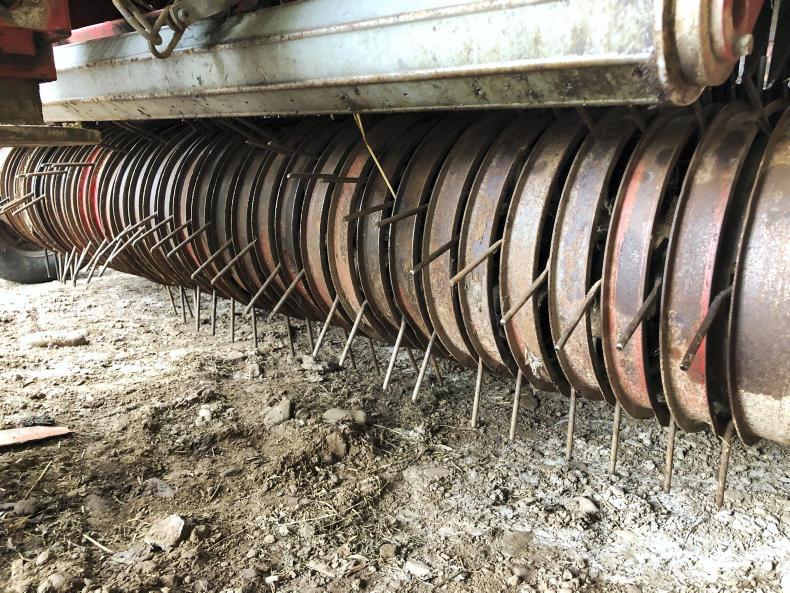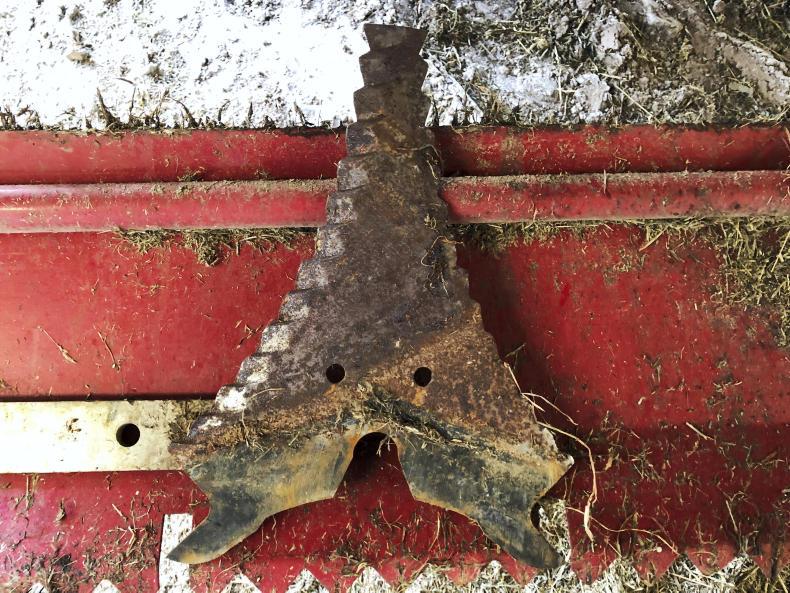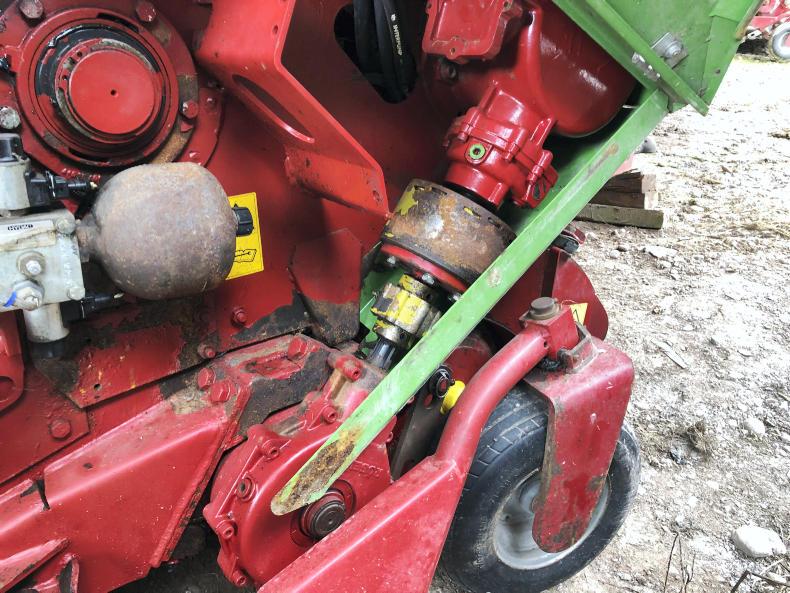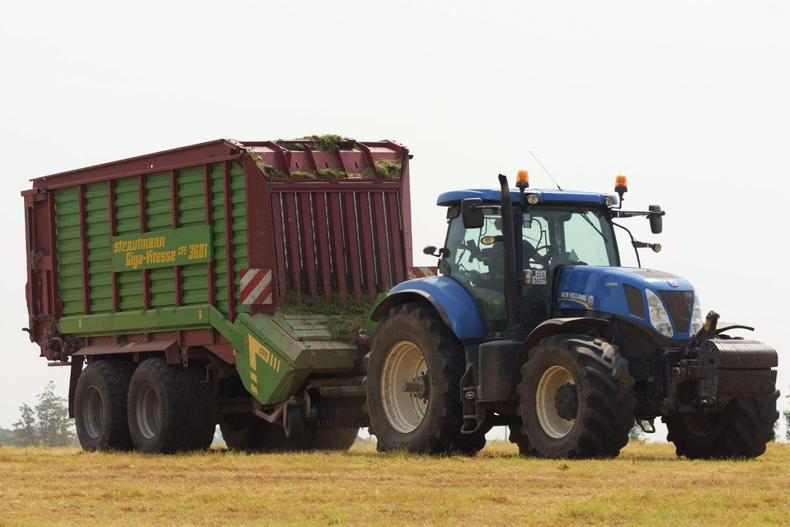Although the majority of grass in Ireland is harvested using self-propelled forage harvesters, a large number of forage wagons are scattered around the country in both contracting fleets and farmers’ yards. Forage wagons still have a pivotal role in silage-cutting and under some circumstances suit better than forage harvesters, with a number of contractors across the country running multiple machines within fleets.
The Irish Farmers Journal met Martin Owens of IAM in the yard of Cork-based contractor Cronin Agri to look at pre-season maintenance checks that should be considered before the upcoming silage season to prevent breakdowns and ensure uptime. It goes without saying that the best approach is to follow guidance given in each individual machine handbook. The wagon we looked at was a Strautmann Giga-Vitesse CFS 3601.

The pickup should be inspected for loose or missing bands and tines. Missing or loose tines should be replaced or tightened.
Pickup and knife bank
Starting at the front, the pickup and chopping unit are arguably the most essential parts of any forage wagon to have in proper working order. Check for any loose or broken tines and tighten or replace if necessary as broken tines leave the remaining tines to pick up the slack, carrying the extra weight of grass.
Although the Strautmann CFS (continuous flow system) pickup system is camless, leaving maintenance easier due to fewer moving parts than standard pickups. Pickups with cam track, cam rollers and cam bearings should be inspected for wear and bearings replaced, if necessary.
Pickup wheels should be in good working order and bearings tight. Pickup wheels that are not set correctly may allow tines to catch and break in the ground or further damage the pickup. Chains and drive sprockets driving the pickup should be checked for tension and wear.
The main intake rotor comes under great pressure. It is important that the bearings on each side are in good condition and receiving a suitable level of grease as bearing failure can often lead to fire or other damage such as scoring of the rotor shaft. When inspecting the rotor, keep an eye out for scraping or scoring from scrapers. Rotors are hard to repair and expensive to replace so take particular attention in ensuring the rotor is in good working order.
Winter storage or a buildup of chaff can cause the knife banks and their moving parts to seize. Each knife has its own retaining spring and breakaway cam lob, which should be free-moving. Spraying with diesel helps to free up all stiff and seized parts. Each knife carrier must be tight and secure. Although other manufacturers’ chopping units may operate differently, the principle remains the same.

All knives should be sharpened or replaced if worn. These double-sided knives allow the operator to easily switch their direction while halving the time they are removed for sharpening.
Blunt knives are probably the single biggest limiting factor to the output of any forage wagon, irrespective of size. It is safe to say unsharpened knives leave the wagon harder driven and cause the tractor to burn more diesel. So, before the season starts, remove all knives – 45 in the case of the Strautmann Giga-Vitesse. Once removed, inspect each knife and if worn or damaged replace them. Ensure that all knives are sharp and ready to go. If fitted with double-sided knives such as the Giga-Vitesse, ensure both sides are sharp. This will reduce downtime as 10 minutes will swap knives around without the need for any tools while on the go, achieving an optimum chop length for longer.

Gearboxes and slip clutches should be inspected and in good working order. Gearbox oil should be replaced if change interval is overdue.
Gearboxes and shafts
Most wagons use gearboxes to distribute power around the machine. Gearboxes are often easily forgot about but it is necessary to check each individual gearbox for its oil level and change interval (found in the operator’s manual), if overdue, drain oil and replace with the recommended oil from the manufacturer. If unsure, change it before the season starts for peace of mind.
The main gearbox will be subject to highest levels of strain, so check splines for wear, condition of bearings and oil seals. Keep in mind that gearboxes will often require different oil types.
It goes without saying to check all PTO shafts and shaft covers for damage. Wide-angle PTO shafts come under particular strain, so it is important to ensure each joint is receiving sufficient grease. Slip clutches should be checked over and in working order. Often, slip clutches can seize if not engaged for a long time.
Discs should be adjusted or replaced if needed, keeping in mind that tightness of the springs determine the torque required to engage the clutch. Some machines are fitted with a number of chains to transfer power. These chains should be checked for wear and that their degree of tension is as recommended, as chains stretch over time.
Loose chains can cause the chain to slip or jump off its drive sprocket, resulting in power loss. Check that oilers and chain greasers are all working properly, that no lines are blocked. Carry a few spare joiner links, possibly on the machine or in the tractor in case of a chain snapping.

Wheel bearings should be checked and in good condition as wagons spend a lot of time travelling the roads with a heavy loads.
Chassis and axles
Many of these machines spend a good deal of their working time travelling heavily laden on the road, so it is essential that brakes, tyres and lights are all in proper working order.
Check the condition and inflation pressures of all tyres, that there are no bad cuts or exposed canvas. All wheel bearings should be checked for movement and replaced, if necessary. Wheel bearing failure could result in loss of a wheel and potentially create untold damage.
All wheel nuts should be checked for tightness and torqued to the manufacturer’s guidelines. The general bogie should be given the once-over, ensuring everything is tight and as it should be, especially around its hinges where wear might be present from a lack of grease.
Forage wagons fitted with steering axles should be checked over for leaking ram seals and worn bushings. Check that the steering axle is locked once pressurised and unlocked when pressure is released. Brakes should be inspected and slack adjusted, if necessary, as good functioning brakes will save the tractors’ brakes.
All lights should be functioning and visible – bad connections should be rectified. Towing eyes should be checked for wear and replaced if worn. Towing eye failure can have serious consequences if the wagon becomes detached from the tractor. Ball-and-spoon hitches will not wear as quick as traditional towing eyes.

Floor slats should be straight. If similar to the one above they should be straightened or replaced. Bent slat could catch in the chassis of the machine.
Floor chains and floor timbers
Check that floor slats are all straight and not bent or missing. If bent, straighten or replace them. Some manufacturers use self-tensioning systems. The Strautmann Giga-Vitesse uses a self-tensioning system. Although these tensioners are self-tensioning, it is no harm to check that they are not seized. It is important that each chain is tensioned equally and not having more of a pull on one side. This could possibly lead to strain or failure of the floor to move. Floor timbers are generally trouble-free, but check for missing or broken timbers.
Control box and sensors
If dry stored, control boxes and electrical connections should be in working order. Moisture can play havoc with electrical connections. Electrical contact spray helps remove moisture. Sensors throughout the wagon should be checked and functional before starting the season. The Strautmann chopping unit is fitted with a beam sensor to determine the location of its knife bank. Check that the beam is in line of sight with the receiver. All sensors should be free from obstruction as obstruction could possibly lead to inaccurate readings on the control box. Before taking the wagon out, run it up and ensure each function is working correctly from the cab.
Although the majority of grass in Ireland is harvested using self-propelled forage harvesters, a large number of forage wagons are scattered around the country in both contracting fleets and farmers’ yards. Forage wagons still have a pivotal role in silage-cutting and under some circumstances suit better than forage harvesters, with a number of contractors across the country running multiple machines within fleets.
The Irish Farmers Journal met Martin Owens of IAM in the yard of Cork-based contractor Cronin Agri to look at pre-season maintenance checks that should be considered before the upcoming silage season to prevent breakdowns and ensure uptime. It goes without saying that the best approach is to follow guidance given in each individual machine handbook. The wagon we looked at was a Strautmann Giga-Vitesse CFS 3601.

The pickup should be inspected for loose or missing bands and tines. Missing or loose tines should be replaced or tightened.
Pickup and knife bank
Starting at the front, the pickup and chopping unit are arguably the most essential parts of any forage wagon to have in proper working order. Check for any loose or broken tines and tighten or replace if necessary as broken tines leave the remaining tines to pick up the slack, carrying the extra weight of grass.
Although the Strautmann CFS (continuous flow system) pickup system is camless, leaving maintenance easier due to fewer moving parts than standard pickups. Pickups with cam track, cam rollers and cam bearings should be inspected for wear and bearings replaced, if necessary.
Pickup wheels should be in good working order and bearings tight. Pickup wheels that are not set correctly may allow tines to catch and break in the ground or further damage the pickup. Chains and drive sprockets driving the pickup should be checked for tension and wear.
The main intake rotor comes under great pressure. It is important that the bearings on each side are in good condition and receiving a suitable level of grease as bearing failure can often lead to fire or other damage such as scoring of the rotor shaft. When inspecting the rotor, keep an eye out for scraping or scoring from scrapers. Rotors are hard to repair and expensive to replace so take particular attention in ensuring the rotor is in good working order.
Winter storage or a buildup of chaff can cause the knife banks and their moving parts to seize. Each knife has its own retaining spring and breakaway cam lob, which should be free-moving. Spraying with diesel helps to free up all stiff and seized parts. Each knife carrier must be tight and secure. Although other manufacturers’ chopping units may operate differently, the principle remains the same.

All knives should be sharpened or replaced if worn. These double-sided knives allow the operator to easily switch their direction while halving the time they are removed for sharpening.
Blunt knives are probably the single biggest limiting factor to the output of any forage wagon, irrespective of size. It is safe to say unsharpened knives leave the wagon harder driven and cause the tractor to burn more diesel. So, before the season starts, remove all knives – 45 in the case of the Strautmann Giga-Vitesse. Once removed, inspect each knife and if worn or damaged replace them. Ensure that all knives are sharp and ready to go. If fitted with double-sided knives such as the Giga-Vitesse, ensure both sides are sharp. This will reduce downtime as 10 minutes will swap knives around without the need for any tools while on the go, achieving an optimum chop length for longer.

Gearboxes and slip clutches should be inspected and in good working order. Gearbox oil should be replaced if change interval is overdue.
Gearboxes and shafts
Most wagons use gearboxes to distribute power around the machine. Gearboxes are often easily forgot about but it is necessary to check each individual gearbox for its oil level and change interval (found in the operator’s manual), if overdue, drain oil and replace with the recommended oil from the manufacturer. If unsure, change it before the season starts for peace of mind.
The main gearbox will be subject to highest levels of strain, so check splines for wear, condition of bearings and oil seals. Keep in mind that gearboxes will often require different oil types.
It goes without saying to check all PTO shafts and shaft covers for damage. Wide-angle PTO shafts come under particular strain, so it is important to ensure each joint is receiving sufficient grease. Slip clutches should be checked over and in working order. Often, slip clutches can seize if not engaged for a long time.
Discs should be adjusted or replaced if needed, keeping in mind that tightness of the springs determine the torque required to engage the clutch. Some machines are fitted with a number of chains to transfer power. These chains should be checked for wear and that their degree of tension is as recommended, as chains stretch over time.
Loose chains can cause the chain to slip or jump off its drive sprocket, resulting in power loss. Check that oilers and chain greasers are all working properly, that no lines are blocked. Carry a few spare joiner links, possibly on the machine or in the tractor in case of a chain snapping.

Wheel bearings should be checked and in good condition as wagons spend a lot of time travelling the roads with a heavy loads.
Chassis and axles
Many of these machines spend a good deal of their working time travelling heavily laden on the road, so it is essential that brakes, tyres and lights are all in proper working order.
Check the condition and inflation pressures of all tyres, that there are no bad cuts or exposed canvas. All wheel bearings should be checked for movement and replaced, if necessary. Wheel bearing failure could result in loss of a wheel and potentially create untold damage.
All wheel nuts should be checked for tightness and torqued to the manufacturer’s guidelines. The general bogie should be given the once-over, ensuring everything is tight and as it should be, especially around its hinges where wear might be present from a lack of grease.
Forage wagons fitted with steering axles should be checked over for leaking ram seals and worn bushings. Check that the steering axle is locked once pressurised and unlocked when pressure is released. Brakes should be inspected and slack adjusted, if necessary, as good functioning brakes will save the tractors’ brakes.
All lights should be functioning and visible – bad connections should be rectified. Towing eyes should be checked for wear and replaced if worn. Towing eye failure can have serious consequences if the wagon becomes detached from the tractor. Ball-and-spoon hitches will not wear as quick as traditional towing eyes.

Floor slats should be straight. If similar to the one above they should be straightened or replaced. Bent slat could catch in the chassis of the machine.
Floor chains and floor timbers
Check that floor slats are all straight and not bent or missing. If bent, straighten or replace them. Some manufacturers use self-tensioning systems. The Strautmann Giga-Vitesse uses a self-tensioning system. Although these tensioners are self-tensioning, it is no harm to check that they are not seized. It is important that each chain is tensioned equally and not having more of a pull on one side. This could possibly lead to strain or failure of the floor to move. Floor timbers are generally trouble-free, but check for missing or broken timbers.
Control box and sensors
If dry stored, control boxes and electrical connections should be in working order. Moisture can play havoc with electrical connections. Electrical contact spray helps remove moisture. Sensors throughout the wagon should be checked and functional before starting the season. The Strautmann chopping unit is fitted with a beam sensor to determine the location of its knife bank. Check that the beam is in line of sight with the receiver. All sensors should be free from obstruction as obstruction could possibly lead to inaccurate readings on the control box. Before taking the wagon out, run it up and ensure each function is working correctly from the cab.











 This is a subscriber-only article
This is a subscriber-only article










SHARING OPTIONS: